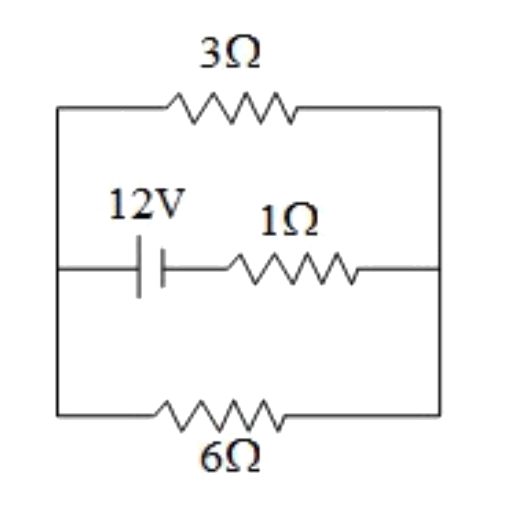When a current flows in a wire of resistance R at a constan t potential difference, then the value of heat produced by a current is inversely proportional to:
1R2
1R
R
R2
To solve the problem, we need to analyze the relationship between heat produced in a wire and its resistance when a current flows through it at a constant potential difference.
1. Understand the relationship between heat, current, and resistance:
The heat produced (H) in a conductor due to current can be described by Joule's law, which states that:
H=I2Rt
where I is the current, R is the resistance, and t is the time for which the current flows.
2. Express current in terms of potential difference and resistance:
According to Ohm's law, the current I can be expressed as:
I=VR
where V is the potential difference across the wire.
3. Substitute the expression for current into the heat equation:
Substitute I in the heat equation:
H=(VR)2Rt
Simplifying this gives:
H=V2Rt
4. Analyze the relationship:
From the equation H=V2Rt, we can see that if V and t are constant, then:
H∝1R
This indicates that the heat produced is inversely proportional to the resistance R.
5. Conclusion:
Therefore, the heat produced by the current is inversely proportional to the resistance of the wire.
Final Answer:
The value of heat produced by a current is inversely proportional to the resistance R.
The heat produced (H) in a conductor due to current can be described by Joule's law, which states that:
H=I2Rt
where I is the current, R is the resistance, and t is the time for which the current flows.
According to Ohm's law, the current I can be expressed as:
I=VR
where V is the potential difference across the wire.
Substitute I in the heat equation:
H=(VR)2Rt
Simplifying this gives:
H=V2Rt
From the equation H=V2Rt, we can see that if V and t are constant, then:
H∝1R
This indicates that the heat produced is inversely proportional to the resistance R.
Therefore, the heat produced by the current is inversely proportional to the resistance of the wire.
The value of heat produced by a current is inversely proportional to the resistance R.
Similar Questions
Knowledge Check
When a current I flows through a resistance R for time t, the electrical energy spent is :
AIRtBI2RtCIR2tDI2R/t
Statement I: A wire of uniform cross-section and uniform resistivity is connected across an ideal cell. Now the length of the wire is doubled keeping volume of the wire constant. The drift velocity of electrons after stretching the wire becomes one-fouth of what it was before stretching the wire.
Statement II: If a wire (of uniform resistivity and uniform cross section) of length l0 is stretched to length nl0, then its resistance becomes n2 times of what it was before stretching the wire (the volume of wire is kept constant in stretching process). Further at constant potential difference, current is inversely proportional to resistance. Finally, drift velocity of free electron is directly proportional to current and inversely proportional to cross-sectional area of current carrying wire.
View SolutionCalculate the current flowing through a wire of resistance 5 Ω connected to a battery of potential difference 3 V.
View SolutionA current of 0.2 A flows through a wire whose ends are at a potential difference of 15 V. Calculate :
the heat energy produced in 1 minute.
View SolutionCalculate the current flowing through a wire of resistance 7.5 Ω connected to a battery of potential difference 1.5. V.
View SolutionThe displacement current flows in the dielectric of a capacitor when the potential difference across its plates-
View SolutionThe displacement current flows in the dielectric of a capacitor when the potential difference across its plates-
View SolutionA current of 0.2 A flows through a wire whose ends are at a potential difference of 15 V. Calculate :
the resistance of the wire,
View Solution

